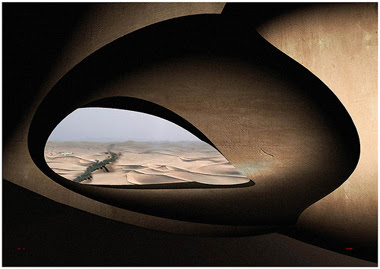- Geoff Manaugh/BLDGBLOG
A 6,000km long stretch of solidified sand dunes is proposed, which will architecturally support the Green Wall Sahara initiative: 24 African countries coming together to plant a shelterbelt of trees right across the continent, from Mauritania in the west to Djibouti in the east, in order to mitigate against the encroaching desert. Sand is solidified into a habitable structure that protects from sand; a permacultural anti-desertification network made from the desert itself.
A particular microorganism, Bacillus Pasteurii, is flushed through the dunescape (an analogy could be made to an oversized 3D printer), which causes a biological reaction that turns the sand into solid sandstone. The initial reactions finish within 24 hours; it would take about a week to saturate the sand enough to make the structure habitable. The bacteria are non-patogenic and die in the process of solidifying the sand. This part of the project relies upon research carried out by professor Jason De Jong's team at the Soil Interactions Laboratory, UC Davis, as well as conversations with professor Stefano Ciurli at the University of Bologna.




No comments:
Post a Comment